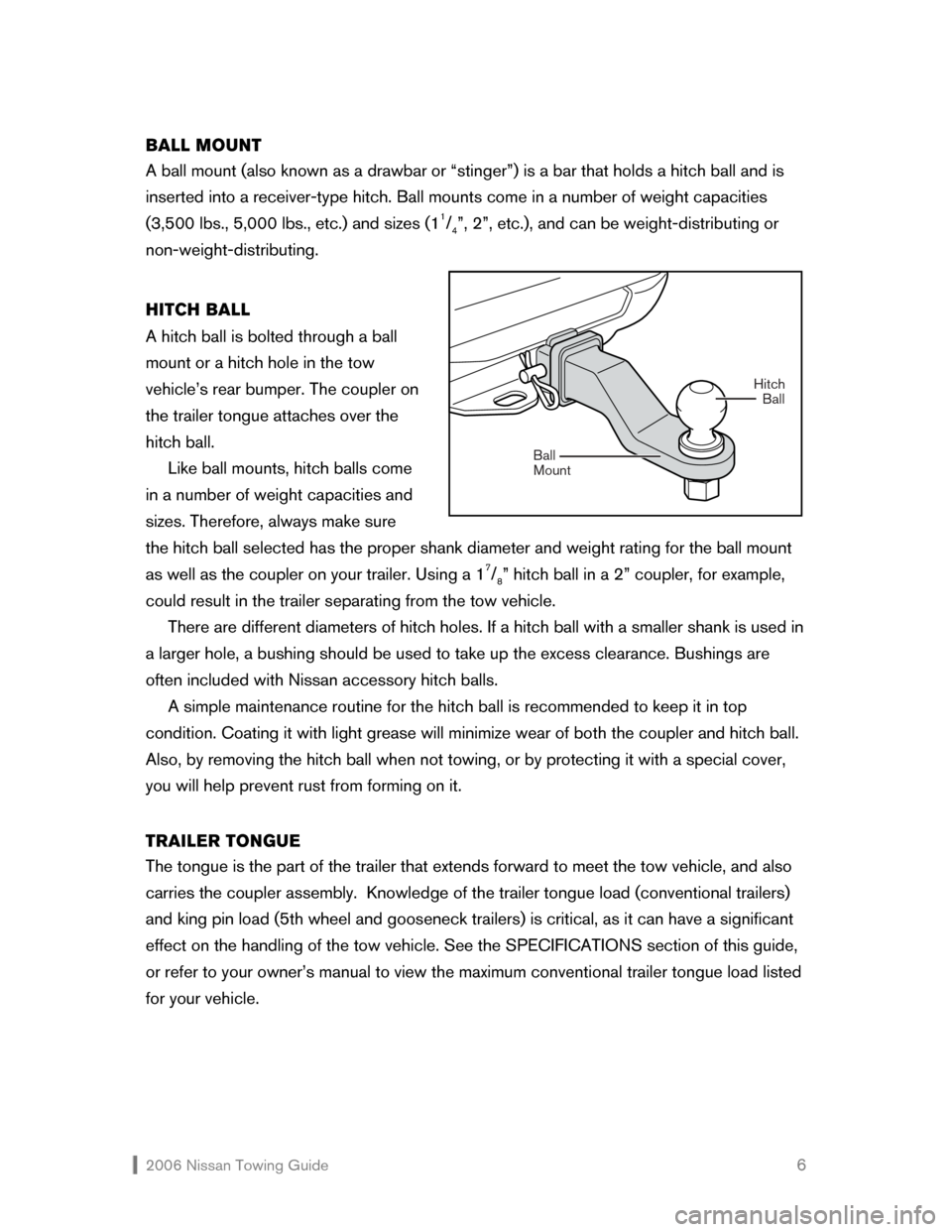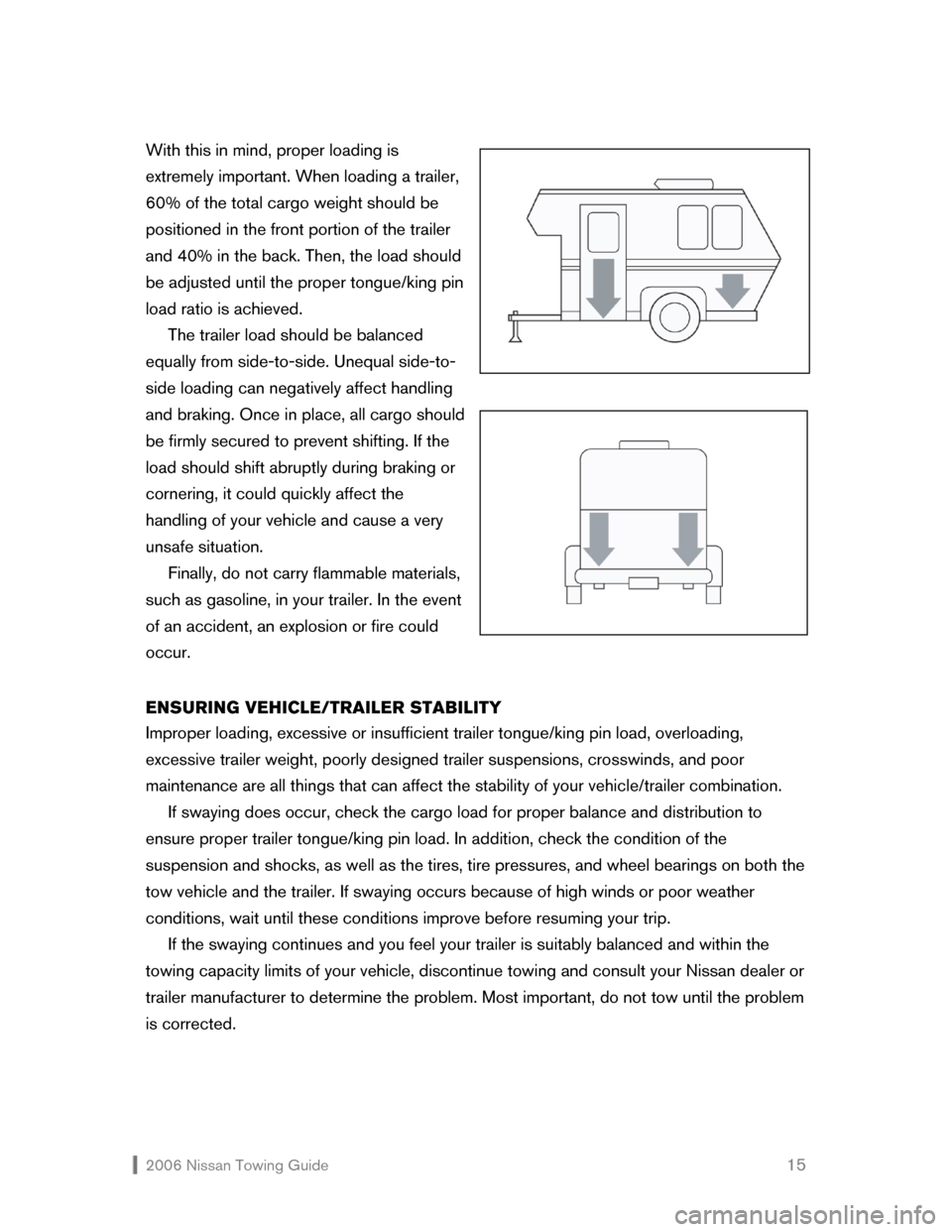maintenance NISSAN XTERRA 2006 N50 / 2.G Towing Guide
[x] Cancel search | Manufacturer: NISSAN, Model Year: 2006, Model line: XTERRA, Model: NISSAN XTERRA 2006 N50 / 2.GPages: 28, PDF Size: 2.12 MB
Page 7 of 28

2006 Nissan Towing Guide 6 BALL MOUNT
A ball mount (also known as a drawbar or “stinger”) is a bar that holds a hitch ball and is
inserted into a receiver-type hitch. Ball mounts come in a number of weight capacities
(3,500 lbs., 5,000 lbs., etc.) and sizes (1
1/4”, 2”, etc.), and can be weight-distributing or
non-weight-distributing.
HITCH BALL
A hitch ball is bolted through a ball
mount or a hitch hole in the tow
vehicle’s rear bumper. The coupler on
the trailer tongue attaches over the
hitch ball.
Like ball mounts, hitch balls come
in a number of weight capacities and
sizes. Therefore, always make sure
the hitch ball selected has the proper shank diameter and weight rating for the ball mount
as well as the coupler on your trailer. Using a 1
7/8” hitch ball in a 2” coupler, for example,
could result in the trailer separating from the tow vehicle.
There are different diameters of hitch holes. If a hitch ball with a smaller shank is used in
a larger hole, a bushing should be used to take up the excess clearance. Bushings are
often included with Nissan accessory hitch balls.
A simple maintenance routine for the hitch ball is recommended to keep it in top
condition. Coating it with light grease will minimize wear of both the coupler and hitch ball.
Also, by removing the hitch ball when not towing, or by protecting it with a special cover,
you will help prevent rust from forming on it.
TRAILER TONGUE
The tongue is the part of the trailer that extends forward to meet the tow vehicle, and also
carries the coupler assembly. Knowledge of the trailer tongue load (conventional trailers)
and king pin load (5th wheel and gooseneck trailers) is critical, as it can have a significant
effect on the handling of the tow vehicle. See the SPECIFICATIONS section of this guide,
or refer to your owner’s manual to view the maximum conventional trailer tongue load listed
for your vehicle.
Hitch
Mount BallBall
Page 11 of 28

2006 Nissan Towing Guide 10
PREPARING
YOUR VEHICLE
BREAK-IN AND MAINTENANCE SCHEDULE
Nissan recommends that you allow a sufficient “break-in” (500 miles) of both the engine
and drivetrain before towing with your new Nissan vehicle. For the first 500 miles that you
tow a trailer, do not drive over 50 mph.
Keep in mind, too, that towing places higher demands and added loads on vehicle
components, so more frequent maintenance is called for. Your service maintenance guide
provides the accelerated maintenance schedule for towing purposes. Engine oil, filter,
transmission oil, and possibly other fluids should be changed more frequently when towing.
MEASURING VEHICLE WEIGHT
The key to safe, efficient towing has to do with weight. Your vehicle — SUV, truck, Minivan,
or passenger car — is capable of carrying and towing only a certain amount of weight. You
must compare your vehicle’s tow-weight ratings with the combined weight of the vehicle,
trailer, and their contents. This will help ensure that the total weight does not exceed any of
your vehicle’s tow weight ratings. There are four weights to consider when towing:
�Š Gross Vehicle Weight
�Š Gross Axle Weight (Front and Rear)
�Š Gross Combined Weight
�Š Trailer Tongue/King Pin Load
These ratings are based upon normal highway driving and may be reduced if operating in
reduced-traction situations, e.g., slippery boat ramps.
NOTE – Attempting to tow loads greater than the GVWR, GAWR, GCWR, and the trailer
tongue/king pin load specified could adversely affect vehicle handling, braking, and
performance. Damage to your vehicle resulting from overloading may not be covered by
your vehicle warranty.
Page 15 of 28

2006 Nissan Towing Guide 14 TIRE PRESSURE
When towing a trailer, increase tow vehicle tire pressures to the recommended cold
specifications. You’ll find these figures in the owner’s manual and on the tire pressure chart
located in the vehicle. Trailer tire condition, size, load rating, and inflation pressure should
be in accordance with the trailer and tire manufacturer’s specifications.
TOWING
SAFETY
Towing can dramatically alter the handling and performance characteristics of your vehicle.
Plus, it puts increased strain on the engine and drivetrain. Therefore, it is always a good
idea to approach towing from the standpoint of safety — whether you’re purchasing
equipment or actually pulling the trailer.
Always make sure your vehicle’s towing capacity is adequate for the trailer you intend to
tow. Buy or lease only quality equipment, and have it installed only by professionals.
In addition, be certain that you have all of the equipment needed for safe towing,
including safety chains/cables, electric trailer brakes, electric trailer brake controller,
breakaway switch, extended rear view mirrors, and so on. All of these items have been
discussed in a previous section of this guide.
With regard to vehicle maintenance, you should follow a more frequent schedule, and
check fluid levels, pressures, tire condition, etc., more often when on the road. See your
owner’s manual for details.
LOADING YOUR TRAILER
Taking the time to load and balance your trailer properly will improve overall handling and
minimize the strain on your tow vehicle. Incorrectly loaded trailers tend to sway or swing
from side to side, upsetting vehicle handling. Careful loading and balancing can help
eliminate these problems.
As mentioned earlier, conventional trailer tongue load should fall between 10-15% of
the total trailer weight, and king pin load — if using a 5th wheel or gooseneck trailer —
should be between 15-25% of the total trailer weight. Excessive tongue/king pin load can
actually push the vehicle down in back, lifting the front wheels to a point where traction,
steering response, and braking are severely reduced. Insufficient tongue/king pin load can
cause instability, which may lead to “tail wagging” or jackknifing.
Page 16 of 28

2006 Nissan Towing Guide 15 With this in mind, proper loading is
extremely important. When loading a trailer,
60% of the total cargo weight should be
positioned in the front portion of the trailer
and 40% in the back. Then, the load should
be adjusted until the proper tongue/king pin
load ratio is achieved.
The trailer load should be balanced
equally from side-to-side. Unequal side-to-
side loading can negatively affect handling
and braking. Once in place, all cargo should
be firmly secured to prevent shifting. If the
load should shift abruptly during braking or
cornering, it could quickly affect the
handling of your vehicle and cause a very
unsafe situation.
Finally, do not carry flammable materials,
such as gasoline, in your trailer. In the event
of an accident, an explosion or fire could
occur.
ENSURING VEHICLE/TRAILER STABILITY
Improper loading, excessive or insufficient trailer tongue/king pin load, overloading,
excessive trailer weight, poorly designed trailer suspensions, crosswinds, and poor
maintenance are all things that can affect the stability of your vehicle/trailer combination.
If swaying does occur, check the cargo load for proper balance and distribution to
ensure proper trailer tongue/king pin load. In addition, check the condition of the
suspension and shocks, as well as the tires, tire pressures, and wheel bearings on both the
tow vehicle and the trailer. If swaying occurs because of high winds or poor weather
conditions, wait until these conditions improve before resuming your trip.
If the swaying continues and you feel your trailer is suitably balanced and within the
towing capacity limits of your vehicle, discontinue towing and consult your Nissan dealer or
trailer manufacturer to determine the problem. Most important, do not tow until the problem
is corrected.